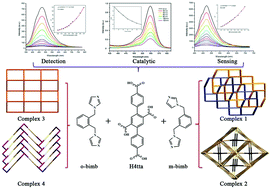Assembly of a series of coordination polymers built from rigid a tetracarboxylate ligand and flexible bis(imidazole) linker: syntheses, structural diversities, luminescence sensing, and photocatalytic properties†
Abstract
Hydrothermal reactions of aromatic terphenyl-4,2′′,5′′,4′-tetracarboxylic acid (H4tta) and transitional metal cations in the presence of two flexible N-donor ancillary ligands afforded four novel coordination polymers, namely, {[Zn(tta)0.5(m-bimb)]·H2O}n (1), [Ni2(tta)(m-bimb)2(H2O)]n (2), [Ni(H2tta)(o-bimb)·H2O]n (3), and [Cd(tta)0.5(o-bimb)]n (4), from solvothermal reactions in the presence of bis(imidazole) bridging linkers (m-bimb = 1,3-bis(imidazol-1-ylmethyl)benzene, and o-bimb = 1,2-bis(imidazol-1-ylmethyl)benzene). Their structures were determined by single-crystal X-ray diffraction analyses and further characterized by elemental analyses (EA), powder X-ray diffraction (PXRD), and thermogravimetric (TG) analyses. Compound 1 displayed a 2-fold 3D → 3D parallel entangled (4,4)-connected bbf net with the point symbol of (64·82)(66)2. Compound 2 featured a predocumented 3D (4,8)-connected (32·53·6)(34·44·59·611) net. Compound 3 exhibited a 2D 4-connected sql sheet with the point symbol of (44·62), and compound 4 showed a 2D 4-connected (32·62·72) kgm sheet. To our delight, fluorescence measurements showed that compound 1 could selectively and sensitively detect Cr3+ cations and nitrobenzene derivatives (nitrobenzene (NB), p-nitrotoluene (PNT), and p-nitroaniline (PNA)), which suggested that CPs of 1 was a promising bifunctional luminescence sensor material that could sense metal ions and small organic molecules. Moreover, 1 showed excellent photocatalytic activity.

- This article is part of the themed collection: Spotlight Collection: MOF Sensors


 Please wait while we load your content...
Please wait while we load your content...